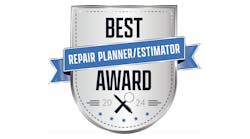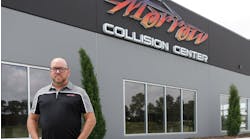According to the J.D. Power 2016 U.S. Initial Quality Study, expected reliability is the most important consideration for 49 percent of car owners when purchasing a vehicle. It also greatly affects brand loyalty. That’s a huge consideration for dealerships, says Kevin Byrnes, and today, one of the most effective ways to combat this issue is via automaker certification programs. While it’s an obvious move for OEMs, the time, money and effort put into obtaining those certifications can actually pay off and boost business for body shops, as well.
At the 10 dealership body shops that Byrnes oversees as collision director of the Suburban Group in metro Detroit, OEM certifications have become a way of life as the shops have moved away from DRP work and invested more heavily in training, equipment and repairing new vehicle materials. And the investment has paid off.
The Business
Suburban Collection has a strong presence in the Detroit market; the luxury dealer group has 42 rooftops in the area selling 58,000 cars per year, 10 state-of-the-art body shops (the smallest of which is 28,000 square feet) that do a combined $48 million each year and handles the fleet administration for all of General Motors North America.
In the metro Detroit area, Byrnes says that the consolidators aren’t much of a presence. Instead, he considers the largest consolidators to be the insurance companies. In fact, for a while, the shops' work was up to 60–65 percent DRP. In particular, AAA was the largest client, with the insurer covering roughly 30 percent of metro Detroit car buyers. The issue, however, was that AAA was also one of the most demanding insurers and Byrnes says it became nearly impossible to repair the high-line vehicles the dealership sells and works on when required to use the best rates.
The Reason
As working on the DRP programs became more difficult and tedious, Byrnes—who has been with the company for 40 years—decided roughly eight years ago to start looking for alternatives in the form of OEM certifications. That’s when the body shops became one of the first eight shops in the country to join the Audi aluminum certification program.
“The main reason we did that is to service our customers,” he says. “We sell those cars and wanted to stay in the family and not have them go outside the group.”
Byrnes knew he could rely on those 58,000 new customers per year, giving him a relatively large target group to tap and turn into long-lasting clientele. In addition, he also felt he had a better chance of capturing fleet business if he was, for example, a Nissan-certified repair facility.
Byrnes says that the shop has always had a strong emphasis on training and proper repair procedures, so while that is an added bonus of OEM certifications, it wasn’t the main reason his operation joined.
While each OEM certification program looks different, Byrnes says that, particularly with the high-line programs, he was intrigued by their ability to restrict structural components and fight off aftermarket parts. Some programs also restrict the number of certified shops in a given geographical area, so Byrnes is assured the business will come to his shops.
Finally, the overarching leading factor was that he could see these programs were only a growing trend.
“I’ve done it because this OEM certification process is going to become a major factor, especially those who are tied to dealerships,” Byrnes says. “OEMs are going to be able to steer work down the road and combat the insurance company.”
Breaking Down the Investment...
...In the facility
Byrnes had to add more aluminum aluminum bays, a multi-metal bay to go through the cleaning process, but did not have to add any additional staff members.
...In equipment
Byrnes says that the American car companies aren’t as strict as the European OEMs are when it comes to equipment. In fact, he says he hardly had to purchase any new equipment when he joined the U.S. OEM programs. When it came to the high-line brands, however, he had to invest in Celette benches (eventually purchasing two per location), wet dry vacuums, rivet guns and a resistance spot welder. Byrnes says that he spent close to $100,000 on rivet guns alone and the investment in equipment can be steep.
...In training
The training is by far the highest investment, Byrnes says. First, you need to ensure that you’re compliant with all of the different programs, satisfy the various audit requirements (such as an annual VeriFacts audit) and are an I-CAR Gold Class shop. He also had to ensure that all of his technicians were I-CAR welding certified, estimators had to go through training for some programs and his technicians became ASE certified.
The high-line programs, such as Audi and Porsche, also require training multiple times per year where technicians are flown out for three days and train on various areas. BMW and Mercedes also have similar requirements.
...In program costs
Byrnes says that the majority of programs cost between $1,000-$4,500 annually per rooftop. He also partnered with the Assured Performance Network a couple years ago, which has helped reduce the cost and eliminate some of the administrative work from his plate.
The Aftermath
Today, Suburban is certified in Porsche, Lamborghini, Bentley, Chrysler, Cadillac CT-6, Maserati, Audi, BMW, Nissan, Mercedes and some of the minor programs through Assured Performance Network. Overall, Byrnes says that the investment has paid off and for some programs, like Audi, the structural components are resisted so much that he has customers towed in from as far as Ohio.
However, not every program has been as successful; he eventually dropped out of the Volkswagen program because Byrnes says there simply was not a return.
Byrnes says that when he initially joined the programs, he religiously tracked his car count and which jobs were coming from the certification programs. The high-line programs yielded the greatest return. While many programs have released consumer-facing apps recently, Byrnes says he has not seen an uptick in work from those programs and believe they could benefit from stronger marketing. The influx in work has also allowed the shops to lower its DRP business; they are no longer a State Farm Select Service facility and DRP work now comprises only 40 percent of jobs.
Bottom line, however, is that the vehicles are staying with the shop and he can virtually guarantee their repair.
“The last thing I want is for the guy who buys a Bentley or Lambo to go to an outside company to have his car repaired,” he says. “It could have a negative effect. That’s why they want more control over this.”



